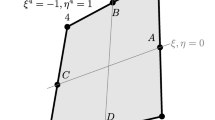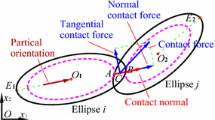Abstract
Fabric modeling may be attempted by modeling fibres or yarns or small fabric units. The first is computationally intensive while the third does not allow relationships between the fabric’s structure and its mechanical properties to be predicted. The second approach has been the most widely used so far. Out of the various ways in which this has been attempted, the finite element approach offers high flexibility while allowing the procedure to be relatively simple because of the availability of user-friendly softwares. This work explores a two-step finite element approach for modeling in-plane fabric shear. A major innovation of the modeling process was that the path of yarns in the fabric was allowed to evolve through the modeling process rather than being pre-defined. The relationship between shear angle and shear stress predicted by this model was compared with that obtained from a picture frame shear experiment. It was found that modeling the yarn with a set of anisotropic properties, gave very good correlation with experimental results.










Similar content being viewed by others
References
F.T. Peirce, The geometry of cloth structure. J. Text. Inst. Trans. 28(3), T45 (1937)
J.S.W. Hearle, H.M.A.E. El-Behery, V.M. Thakur, The mechanics of twisted yarns: tensile properties of continuous-filament yarns. J. Text. Inst. Trans. 50(1), T83 (1959)
E. Onder, G. Baser, A comprehensive stress and breakage analysis of staple fiber yarns part I: stress analysis of a staple yarn based on a yarn geometry of conical helix fiber paths. Text. Res. J. 66(9), 562 (1996)
M. Konopasek, Classical elastica theory and its generalizations, in Mechanics of Flexible Fibre Assemblies, Nato Advanced Study Institutes Series, Series E: Applied Science—No. 38, ed. by J.W.S. Hearle, J.J. Thwaites, J. Amirbaya (Sijthoff and Noordhoff, Pittsburgh, 1980), p. 255
D.W. Lloyd, F. Mete, K. Hussain, An approach to the theoretical mechanics of static drape. Int. J. Cloth. Sci. Technol. 8(3), 43 (1996)
D.M. Stump, W.B. Fraser, Asimpified model of fabric drape based on ring theory. Text. Res. J. 66(8), 506 (1996)
J.R. Postle, R. Postle, Modeling fabric deformation as a nonlinear dynamical system using Bäcklund Transformations. Int. J. Cloth. Sci. Technol. 8(3), 22 (1996)
A. Kemp, An extension of Peirce’s cloth geometry to the treatment of non-circular threads. J. Text. Inst. Trans. 49(1), T44 (1958)
S. Kawabata, M. Niwa, H. Kawai, The finite deformation theory of plain weave fabrics part I: the biaxial-deformation theory. J. Text. Inst. 64(1), 21 (1973)
S. Kawabata, M. Niwa, H. Kawai, The finite deformation theory of plain weave fabrics part II: the uniaxial-deformation theory. J. Text. Inst. 64(2), 47 (1973)
S. Kawabata, M. Niwa, H. Kawai, The finite deformation theory of plain weave fabrics part III: the shear-deformation theory. J. Text. Inst. 64(2), 62 (1973)
D.E. Breen, D.H. House, P.H. Getto, A physically-based particle model of woven cloth. Vis. Comput. 8(5,6), 264 (1992)
D.E. Breen, D.H. House, M.J. Wozny, A particle-based model for simulating the draping behavior of woven cloth. Text. Res. J. 64(11), 663 (1994)
B.B. Boubaker, B. Haussy, J.F. Ganghoffer, Consideration of the yarn–yarn interactions in meso/macro discrete model of fabric. Part I: single yarn behavior. Mech. Res. Commun. 34(4), 359 (2007)
B.B. Boubaker, B. Haussy, J.F. Ganghoffer, Consideration of the yarn–yarn interactions in meso/macro discrete model of fabric. Mech. Res. Commun. 34(4), 371 (2007)
X. Provot, in Deformation Constraints in a Mass-Spring Model to Describe Rigid Cloth Behavior. Proceedings of Graphics Interface’95 (Quebec, Canada, 1995), 17–19 May, p. 147
E.M. Parsons, T. Weerasooriya, S. Sarva, S. Socrate, J. Mech. Phys. Solids 58(11), 1995 (2010)
P. Boisse, M. Borr, K. Buet, A. Cherouat, Finite element simulations of textile composite forming including the biaxial fabric behavior. Compos. B Eng. 28(4), 453 (1997)
J. Page, J. Wang, Prediction of shear force using 3D non-linear FEM analyses for plain weave carbon fabrics in a bias extension state. Finite Elem. Anal. Des. 38(8), 755 (2002)
P. Badel, E. Vidal-Salle, P. Boisse, Computational determination of in-plane shear mechanical behaviour of textile composite reinforcements. Comput. Mater. Sci. 40(4), 439 (2007)
N. Hamila, P. Boisse, S. Chatel, Finite element simulation of composite reinforcement draping using a three node semi discrete triangle. Int. J. Mater. Form. 1(S1), 867 (2008)
D. Wang, Y. Jiao, J. Li, 3D geometrical model of plain weave fabrics for finite element analysis. Adv. Mater. Res. 332–334, 1635 (2011)
P. Boisse, N. Hamila, E. Vidal-Salle, F. Dumont, Simulation of wrinkling during textile composite reinforcement forming. Influence of tensile, in-plane shear and bending stiffnesses. Compos. Sci. Technol. 71(5), 683 (2011)
H. Lin, M.J. Clifford, A.C. Long, K. Lee, N. Guo, A finite element approach to the modeling of fabric mechanics and its application to virtual fabric design and testing. J. Text. Inst. 103(10), 1063 (2012)
G. Lebrun, M.N. Bureau, J. Denault, Evaluation of bias-extension and picture-frame test methods for the measurement of intraply shear properties of PP/glass commingled fabrics. Compos. Struct. 61, 341 (2003)
J.J. Lin, in Prediction of Elastic Properties of Plain Weave Fabric Using Geometrical Modeling, ed. by P.D. DubrovskiIn. Woven Fabric Engineering (2010), ISBN: 978-953-307-194-7, InTech
J.W.S. Hearle, W.J. Shanahan, An energy method for calculations in fabric mechanics, part II: examples of application of the method to woven fabrics. J. Text. Inst. 69(4), 92–100 (1978)
Author information
Authors and Affiliations
Corresponding author
Rights and permissions
About this article
Cite this article
Chichani, S., Guha, A. A Method of Modeling Fabric Shear using Finite Element Analysis. J. Inst. Eng. India Ser. E 96, 1–7 (2015). https://doi.org/10.1007/s40034-014-0051-z
Received:
Accepted:
Published:
Issue Date:
DOI: https://doi.org/10.1007/s40034-014-0051-z




